18 May – Dubrovnik Hrvatska (Croatia)
Arrival into Dubrovnik amid blue seas, sun and warmth. Short walk to Rooms Kaja where my host reminds me of Dean but with an accent and curlier hair. Quickly set off for Dubrovnik – among the 10 best medieval walled cities in the world. Explored the 1.24 miles of wall encircling the old city. Almost all roofs in the city were destroyed by the 1991 aggressions. The regime in Montenegro led by Momir Bulatović, installed by and loyal to Serbia’s Slobodan Milošević, claimed Dubrovnik was historically part of Montenegro. This was in spite of a large Croat majority population with few Montenegrins and a mere 6% of Serbs residing there. Many considered Bulatović’s claims as part of Milošević’s nationalist plan to build a Greater Serbia as Yugoslavia collapsed. The citizens of Dubrovnik were sitting ducks as Serbs, Bosnians and JNA (Yugoslav National Army) fired down from Srd Mountain directly behind the city.
Dubrovnik has rebuilt, the walls are intact, roofs replaced, historic character retained, and the views magnificent. Lots of stairs to climb and bastions to explore. I have looked forward to this revisit since 1986 and it has not disappointed. Alas, no pictures of Marshal Josip Broz Tito in the stores. Squares are filled with tourists but many narrow streets to roam. Visited St. Blaise’s Church, the patron saint of Dubrovnik. Met Chrystine for a wonderful dinner of feta cheese salad and mussels overlooking the Adriatic and city walls. George Bernard Shaw visited the city in 1929 and said: “If you want to see heaven on earth, come to Dubrovnik.” So true.
Tomorrow I too will be one of these thundering hordes.
19 May – Herceg Novi “New Herceg” Montenegro
Glorious morning on my terrace overlooking the spectacular blue Adriatic. A bus takes me to the airport to meet my travel mates. Such a beautiful day wasted in an airport before driving the 30 minutes south through two border crossings and into Montenegro and the small walled stari grad of Herceg Novi on the Bay of Kotor.
Herceg Novi is a medieval city founded in 1382 and predominately Serb. The city has been under the rule of a multitude of rulers: Turks, Venetians, Spanish, French, Russians, Austro-Hungarians and Italians, then liberated by partisans in 1943.
My roommate is Carol from North Carolina. Our hotel is nice, dinner is plentiful and tasty, even though our tour leader tried to push that awful Hungarian green palinka* on me. The evening was pleasant enough for a walk into town, remains to be seen how some of this group manage its hundreds of steps.
*The national liquor of Hungary (our guides and bus driver are Hungarian and the hotel is Hungarian) is palinka, a brandy that’s somewhere between 60% and 70% alcohol. No taste bud should be subjected to it.
20 May – Herceg Novi aka Crna Gora
Morning boat ride on the Adriatic for fine views of Austro-Hungarian forts at the mouth of Bay of Kotor. Stark 6214′ Mount Orjen provides a dramatic back drop to deep blue seas. Martyrs are entombed atop its peaks; Tito and his partisans fought and sheltered here. Fishermen and one big shark dot the sea. We stopped at the Blue Cave – you can swim and look “Avatar” blue under water. The sea bunkers were more impressive; carved into the rock and used to hide Yugoslavia’s submarine fleet. “They tell us we are better off now but I am not so sure.” Brief stop at the old Austro-Hungarian border town of Port Rose before returning to the foot of the Turkish Forte Mare for a “light” seafood lunch.
Then, in an attempt to kill some of the 23 “elder” travelers, we climbed 1001 steps into the old city. Not much to explore. Climbed more steps to the Turkish Kanli Kula, Bloody Tower fortress, used as a jail and last stop for troublemakers. Atop the hill, great views of the entire stunning bay are possible.
Before dinner, we had an excellent talk about Montenegro given by a Brit who has lived here for 7 years. He mentioned the priests punching it out south of here over a new Serb church; Serb and Montenegrin orthodox churches have split. Tito is well respected here and a lot of partisans still alive and proud to relate stories of the war. It is a well-armed state; everyone has a gun and fire into the sky in celebration. Warned if we hear shots to duck as the bullets are coming down almost as fast as going up. They do this at all weddings and our speaker looks forward to a lot of weddings so they run out of bullets.
21 May – National Independence Day 2006 for Montenegro
Traveled along the deep fjord of Kotor Bay, spectacular mountains in the background and small villages and trees for miles. Beautiful scenery that could be more appreciated from the water. Area is well-developed, homes are large and attractive, villages small. Stopped for short walks around Perast, Kotor, and Budva. In Perast we took a boat to a man-made rock island and site of Lady of the Rocks, a church dedicated to seamen.
Kotor is an awesome walled city, reminding me of the great walls of China, with its wall weaving up the steep mountainside and along the peaks. Built by the Venetians against the Turks – like any Turk would cross those high and barren peaks then face an ornery Montenegrin. City itself is small with a few churches and lots of tourist shops. Enjoyed walking around the streets. Ate lunch before busing to Budva.
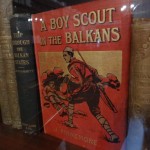 Budva, a 7th and 8th century walled city, is less dramatic than Kotor but has the same variety of churches and lots of shops. The Citadel enjoys a commanding view and an incredible library of Balkan history books. The ornate orthodox church is worth a visit. We returned across the bay via ferry. The landscape is beautiful, the fjord awesome. For the adventurous, I would recommend breasting the mountains and traveling inland to enjoy the land and people.
Budva, a 7th and 8th century walled city, is less dramatic than Kotor but has the same variety of churches and lots of shops. The Citadel enjoys a commanding view and an incredible library of Balkan history books. The ornate orthodox church is worth a visit. We returned across the bay via ferry. The landscape is beautiful, the fjord awesome. For the adventurous, I would recommend breasting the mountains and traveling inland to enjoy the land and people.
22 May – Dubrovnik (Republic of Ragusa) Hrvatska
What started in rain ended to be a sunny day for our short walking tour through Rector’s Palace, Franciscan Monastery, Catholic church and then to lunch. Ate at same restaurant where I ate Friday night. Lecturer Igor gave wonderful talk on Dubrovnik, the war, and history of area as he graphically tried to explain the unexplainable. Talked of respect for Tito but his memory is fading. Controversy continues over Archbishop Alojzije Stepinče and his support of forced conversions and the Croatian Ustaša government during WWII. Igor’s grandfather was a Communist, the other grandfather fought with the partisans.
Displayed a sample of the food packets air-dropped by US, a cause of many Croats getting hooked on peanut butter. There is still distrust and many rumors and false ideas about the “other” nationalities. Cannot safely park a car with Bosnian plates in Dubrovnik. Just last year a restaurant refused service to Serbian women. It seems the Serbs, Croats, and Muslims hate each other. “Only way we can tell Serb from Croat is by family names but they all carry mental files categorizing each person they meet.“
Some of group wanted to return to hotel after talk but thankfully more wanted to stay so we compromised to leave at 5:30. I just don’t understand coming here then not wanting to use your time. Nor coming unprepared without a jacket or umbrella, especially when we leave the hotel in rain. Many of group have traveled but mostly on tours and taken care of by others. This could get ugly.
Carol and I rode a cable car up the mountain for views of Dubrovnik. The Bosnian border is less than a mile. We visited the synagogue and churches, alleys and a few shops. Then we bussed across the border for the third time. Both Croatia and Montenegro collect our passports to check and stamp each crossing. Good that I have extra pages.
The food has been very good. Fruits and vegetables are excellent as is the sea food. Pivo aka beer is good. No good reports on wine as yet.
23 May – Trogir and Split
Beautiful sunny day driving to Split via 6 border crossings. In 1699, the Republic of Ragusa sold two mainland patches of its territory to the Ottomans in order to avoid being caught in the clash with advancing Venetian forces. Today this narrow 7-mile strip of land belongs to Bosnia and Herzegovina (BiH) and is its only direct access to the Adriatic. It also represents four of our border crossings. Cars backed up at the border, the wait dependent upon your license plate.
Croatia is building a bridge to skirt Bosnian roads. It will not be named Tudjman as a newer bridge in Dubrovnik is already so named. More insults for Serbs as Croatian President Tudjman had been investigated for war crimes against humanity. More rock walls along the mountainsides, 6 miles of them built against the Venetians. Reminds me of China’s Great Wall as it climbs along the mountain peaks. The bay is full of oyster and mussel farms. Stopped for lunch in Omis. Restaurant was deep into canyons of towering rock but out of our way.
Trogir, 30 miles around the bay beyond Split, is the best-preserved medieval Romanesque-Gothic city in Central Europe. Romanesque, Gothic, Renaissance and Baroque castle, tower, dwellings, and palaces are surrounded by high walls. I love these tidy little walled cities. Trogir’s grandest architecture is the Church of St. Lawrence known for a portal by Radovan, the most significant work of the Romanesque-Gothic style in Croatia. Its water supply, from the Jadro River, is the same source that supplied Diocletian’s Palace. No surprise as the sea and river water is as clear as I have ever seen. After a walking tour that spent most of the time at the church, I walked to the 1420 fortress and around the narrow streets, more like alleys.
A fortress appears atop ever peak, protecting Adriatic shores from pirates and whoever was the enemy of the month. Entering Split, a massive fortress rests atop the mountain east of Solona, Diocletian’s birthplace.
In 305, 60-year-old Diocletian retired from his job as Emperor of the Roman Empire to farm cabbages in a marvelous palace so large it became the city of Split. His octagonal mausoleum is in city center. He came to power amid blood and intrigue, yet his reign brought stability. He ruled for 20 years, stopped the cycle of civil wars, and initiated administrative and military reforms lasting a thousand years. Today, Split is a wonderful port. I can understand why Diocletian retired here.
My hotel is in a corner of Diocletian’s Palace, so I guess I can say Diocletian slept here.
24 May – retirement home of Diocletian
Blue sky and sunny for our walking tour of Diocletian’s Palace. If I ignore all the stores, I get a sense of the walls and walkways of Diocletian’s era. Under the palace, the rooms are damp but pretty much unchanged since 300 AD. Diocletian’s mausoleum is in the center of the Palace but one of his Christian victims lies there now while the Emperor’s body has disappeared, probably sleeping with the fishes in the Adriatic. Excellent guide, though no mention of growing cabbages.
Split is a tourist spot but at least a great one. Visited the fish, green and flea markets, a church to Domnius their patron saint, Franjo Tuđman Plaza probably close to a saint in Croatia (a war criminal to the Muslims and Serbs), had a beer while people-watching at the port. After lunch, Carol and I went to Gallery of Ivan Meštrović, a favorite son of Croatia and wonderful sculptor and admirer of Rodin. I like his bronzes. He also created the wooden panels for the nearby Holy Cross Chapel. He did the two Indian statues in Grant Park in Chicago. Ivan became a US citizen and died in South Bend IN. But alas, he also liked Tuđman.
Back to same restaurant where we ate dinner yesterday, lunch today. No imagination as Split certainly does not lack good places to eat. Beautiful evening so walked around the Palace enjoying the lights.
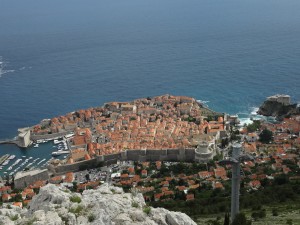

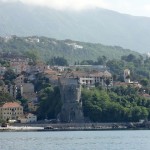

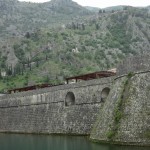


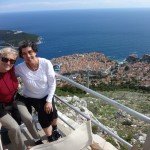
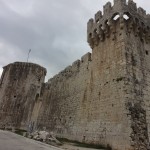

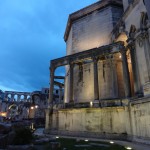
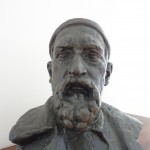
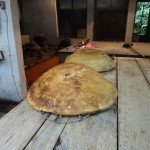
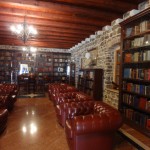

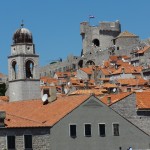
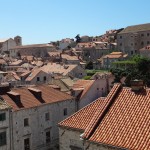
0 Comments